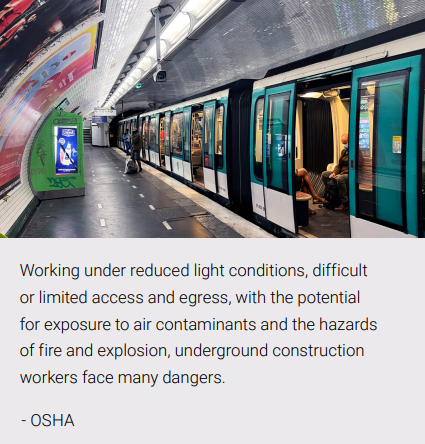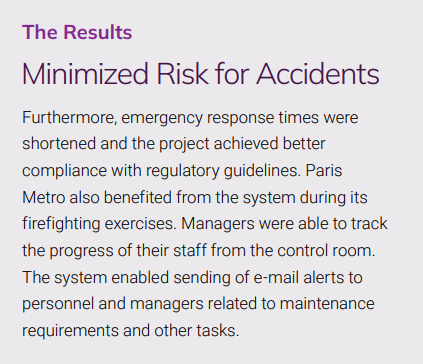Overview
Paris Metro wanted to improve the safety of hundreds of construction workers in tunnels with Litum, while expanding its underground rail line. Litum’s lone worker safety solution that accompanied the construction project consisted of UWB RFID-based sensors worn by personnel, and their location data was collected through a mesh network set up in the tunnel for emergency reporting.
Objective
A system that would ensure worker safety throughout the multi-year project.
Technology
Supported by Litum propriatery software, battery operated UWB RFID tags, anchors, gateways are installed in the construction area
Integration
Integrated with the company’s time and attendance system for headcount accuracy.
The Company
The project commenced in 2017 and was overseen by public enterprise Société du Grand Paris. It consists of multiple new rapid-transit lines in the Paris region. The latest rail line comprises five stretches of tunnel, totaling 33 kilometers (20 miles) and requires approximately 400 workers. A tunnel boring machine (TBM) is used to drill out the tunnel.


The business problem
The project had to meet strict safety regulations allowing only authorized workers in restricted areas. Also workers were tracked real-time to avoid unsafe behaviours.
The Solutions
The project had to meet strict safety regulations allowing only authorised workers in restricted areas. Also workers were tracked real-time to avoid unsafe behaviours. All workers were provided with tags and anchors that communicate with the badges were installed througout the tunnel. Each worker is assigned an ID badge that is attached to that person’s hardhat when reporting to the job site.
The unique ID number transmitted by the battery- powered badge is linked to the employee ID and job title in Litum IoT software. The system forwards each tag ID and its location via the mesh network structure.
The precise location of tags is calculated by Litum location engine software by using proprietary algorithms. Thus, as each worker moves around the worksite and through the tunnel, the location information is displayed on a dashboard map as a dot in real time.
In the event of an incident, such as an unauthorized individual entering a restricted area, an alert is issued directly to managers or supervisors onsite, who can then quickly address the problem.
For emergencies, the system prompts each employee’s badge to vibrate and make an audible warning, and the software can display each worker’s location on a mounted screen to indicate evacuation routes.


Challenges
The main challenge was to create a network within underground tunnels where working environment is harsh and usually very unpredictable.
Amplifiers were used to enhance bandwidth within tunnels.
IP67 rated hardware preferred to meet the demands of the harsh working environment.
Throughout the tunnel, RTLS UWB nodes were installed every 100 meters as a precaution for any other emergencies so that workers could activate the alarm system.
- SEO Powered Content & PR Distribution. Get Amplified Today.
- PlatoData.Network Vertical Generative Ai. Empower Yourself. Access Here.
- PlatoAiStream. Web3 Intelligence. Knowledge Amplified. Access Here.
- PlatoESG. Carbon, CleanTech, Energy, Environment, Solar, Waste Management. Access Here.
- PlatoHealth. Biotech and Clinical Trials Intelligence. Access Here.
- Source: https://www.iot-now.com/2024/01/12/141865-lone-worker-safety-with-location-insights/
- :is
- :where
- $UP
- 100
- 20
- 2017
- 33
- 400
- a
- Able
- access
- accidents
- accompanied
- accuracy
- achieved
- address
- AIR
- alarm
- Alert
- alerts
- algorithms
- All
- Allowing
- also
- an
- and
- any
- approximately
- ARE
- AREA
- areas
- around
- AS
- assigned
- attendance
- Audible
- authorised
- authorized
- avoid
- badges
- Bandwidth
- battery
- behaviours
- Better
- Boring
- business
- by
- calculated
- CAN
- challenge
- commenced
- communicate
- Company’s
- compliance
- comprises
- conditions
- consists
- construction
- contaminants
- control
- could
- create
- dangers
- dashboard
- data
- demands
- difficult
- directly
- Display
- displayed
- DOT
- during
- each
- emergency
- Employee
- enabled
- Engine
- enhance
- ensure
- entering
- Enterprise
- Environment
- Ether (ETH)
- Event
- Every
- expanding
- explosion
- Exposure
- Face
- Fire
- five
- For
- from
- Furthermore
- grand
- guidelines
- had
- Hardware
- headcount
- HTTPS
- Hundreds
- ID
- improve
- in
- incident
- indicate
- individual
- information
- insights
- iot
- Issued
- IT
- ITS
- Job
- latest
- light
- Limited
- limited access
- Line
- lines
- linked
- location
- machine
- Main
- maintenance
- make
- Managers
- many
- map
- max-width
- Meet
- mesh
- Mesh network
- Metro
- moves
- multi-year
- multiple
- network
- New
- news
- nodes
- now
- number
- of
- on
- only
- operated
- or
- Other
- out
- paris
- Personnel
- plato
- Plato Data Intelligence
- PlatoData
- potential
- powered
- precise
- preferred
- Problem
- Progress
- project
- prompts
- proprietary
- provided
- public
- quickly
- Rail
- rated
- real
- real-time
- Reduced
- region
- regulations
- regulatory
- related
- Reporting
- Reports
- Requirements
- requires
- response
- restricted
- Results
- Risk
- Room
- routes
- Safety
- Screen
- sending
- sensors
- set
- shortened
- site
- So
- société
- Software
- solution
- Staff
- strict
- structure
- such
- system
- TAG
- tasks
- that
- The
- their
- then
- Through
- throughout
- Thus
- time
- times
- Title
- to
- totaling
- track
- tunnel
- unauthorized
- under
- unique
- unpredictable
- used
- using
- Using Proprietary
- usually
- very
- via
- wanted
- warning
- was
- were
- when
- while
- WHO
- with
- within
- worker
- worker safety
- workers
- working
- would
- zephyrnet











